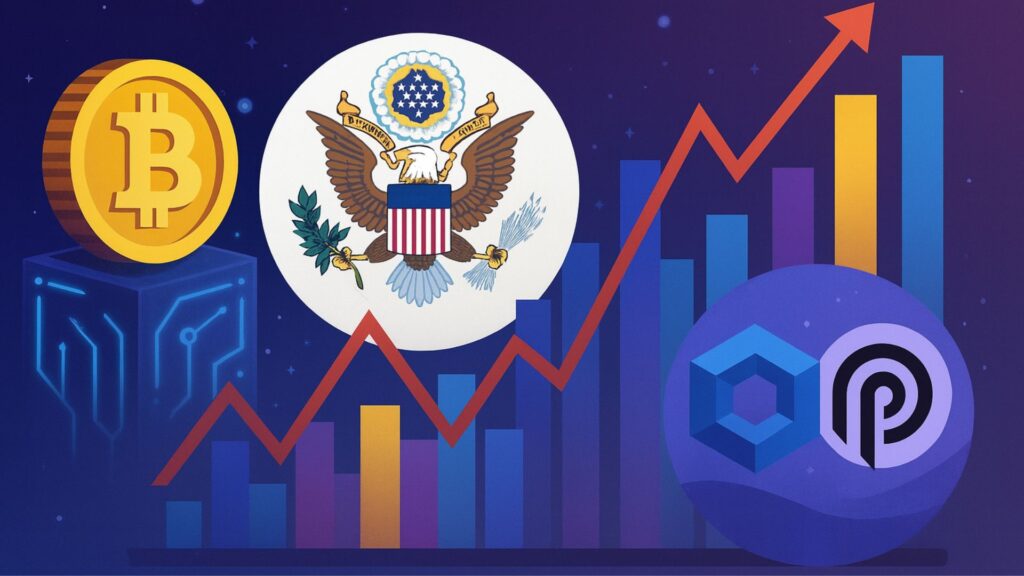For the first time, the United States government has placed its core economic data directly onto blockchains.
By working with Chainlink and Pyth, two leading oracle networks, the Department of Commerce has begun publishing GDP and other essential metrics across multiple chains, including Bitcoin and Solana.
The move is not only about experimenting with new technology, but it also signals a shift towards transparency, accountability, and global accessibility of economic truth.
With this data written onchain, it becomes verifiable, permanent, and available to anyone, anywhere, without filters or intermediaries.
US Government Publishes Data On-Chain!
In August 2025, the United States Department of Commerce confirmed its partnership with Chainlink and Pyth to deliver economic statistics through blockchain networks.
Chainlink integrated with the Bureau of Economic Analysis to provide critical indicators such as Real GDP, the Personal Consumption Expenditures Price Index, and Real Final Sales to Private Domestic Purchasers through its oracle feeds.
Pyth was tasked with publishing the nation’s GDP output, with a focus on annualised figures as a consistent measure of economic performance both domestically and internationally.
The first release under this programme was the second quarter GDP data for 2025. The Department of Commerce published the data across nine blockchains, including Bitcoin, Ethereum, Solana, Tron, Stellar, Avalanche, Arbitrum, Polygon, and Optimism.
Each chain received either a hash or a topline figure that permanently records the dataset in a decentralised and tamper-proof environment. Leading exchanges such as Coinbase, Gemini, and Kraken also assisted in distributing the data to ensure broad accessibility.
Commerce Secretary Howard Lutnick described the move as a milestone for government data publication. He emphasised that America’s economic truth has now been made immutable and globally accessible.
This statement reflected both a commitment to transparency and the administration’s intention to strengthen the country’s position as a leader in cryptocurrency and blockchain adoption.
Publishing economic data onchain is more than a symbolic gesture. It ensures a timestamped and verifiable record of official statistics, preventing manipulation and reducing the risks of delayed or selective disclosure.
By working with Chainlink and Pyth, the government benefits from reliable and secure oracle delivery, avoiding the weaknesses of centralised systems that can be altered or compromised.
Why Is This Beneficial?
The decision to place US economic data onchain carries significant implications for stakeholders across society. Citizens benefit from the assurance that government statistics are transparent and verifiable, eliminating doubts about accuracy or political influence.
Businesses gain a reliable foundation for planning and investment, with figures that cannot be revised quietly or obscured. International institutions also receive a clear and accessible reference point, strengthening the integrity of cross-border comparisons and financial negotiations.
Developers and innovators are among those who may gain the most. Real-time, onchain data can serve as a base layer for decentralised applications and automated contracts.
For example, lending platforms could adjust borrowing conditions in response to changes in GDP growth, or insurance contracts might reference consumer expenditure metrics directly without waiting for delayed reports.
By embedding economic data into blockchains, both private markets and public policy processes can function with greater speed, accuracy, and confidence.
This initiative also has wider implications for governance. If the United States sets a precedent by recording its economic data across multiple chains, other nations may follow.
An international system of verifiable, synchronised economic reporting could emerge, reducing disputes over figures that often underpin trade agreements or monetary policies.
In this sense, publishing data onchain is not just a technical shift, as it is a potential step towards a more transparent model of global cooperation.
Challenges remain, particularly around accessibility for those unfamiliar with blockchain tools and the ability of networks to handle large datasets. However, these are issues of infrastructure and education rather than barriers to the principle itself.
The core achievement here is that a government has demonstrated it is possible to transform official reporting into a shared digital resource, open to all and resistant to interference.
Conclusion
The decision by the US government to publish economic data onchain with the help of Chainlink and Pyth marks an important turning point in how public information is delivered and trusted.
By making GDP and other key metrics verifiable across multiple blockchains, the Department of Commerce has strengthened transparency while opening the door to innovation.
For citizens, businesses, policymakers, and international observers, this initiative provides a new foundation of economic truth that is open, immutable, and globally accessible.
It sets the stage for a wider transformation in government data practices and may influence how transparency is pursued worldwide.

